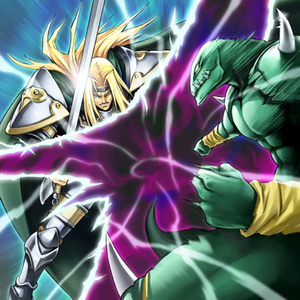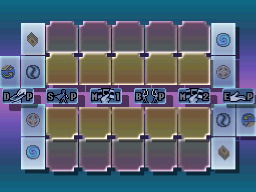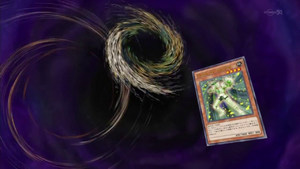Banish

Banish (Japanese:
Banished cards are not placed in any particular zone. Banished cards should be kept next to the Graveyard, in clear view of both duelists;[1] banished cards are typically placed in a single pile, in a manner similar to the Graveyard. Most video games place banished cards in a single pile located to the right of the Graveyard.
Contents
Mechanics[edit]
Because banishing a card causes it to leave its current location, banishing a card on the field causes it to leave the field. Consequently, if a Monster Token is banished face-up, it is simply removed from the game rather than placed with the other banished cards.
Banished cards cannot be destroyed. Returning a banished card to the Graveyard is not considered to be sending that card to the Graveyard, and can be done even if a card like "Dimensional Fissure" is active.
Banished face-down[edit]
By default, cards are banished face-up, with these cards being public knowledge. However, several cards can banish cards face-down (such as "Ghostrick Skeleton" and "Pot of Desires"); a card that is banished face-down is not public knowledge and can thus only be looked at by its possessor. A card that is banished face-down cannot be affected by cards that specify properties of the banished card, other than the card that banished it. (e.g. "Burial from a Different Dimension" cannot return face-down banished monsters to the GY, but "Virtual World Hime - Nyannyan" can shuffle a face-down banished card to the Deck.) The number of banished cards (including face-down banished cards) is public knowledge.
Monster Tokens cannot be banished face-down.
Temporarily banished[edit]
Card effects can temporarily banish cards until a later point in time, at which point the card returns to its original location. Returning a monster to the field from temporary banishment does not count as a Special Summon.
If a card controlled by a player that is not its owner is temporarily banished by a card like "Interdimensional Matter Transporter", while banished it will be in the possession of its owner, but when it returns to the field it will return to the side of the field of the player that controlled it when it was banished. If its owner does not have an unoccupied Zone on the field to return it to, the card is instead sent to the Graveyard. Furthermore, if the effect that gave temporary control of that card to the opponent is no longer active, it will then return to the original owner.[2] If a card would be banished when it leaves the field, if it is temporarily banished by another card effect, it does not return to the field.
Banished cards[edit]

Banished cards are not considered to be placed in any actual location, and as such there was no noun used to refer to their placement, or them as whole, in the TCG until Phantom Nightmare, where "your banishment" was first used to refer to "cards in your possession that are banished" (although only on some cards). A somewhat similar change was introduced to the OCG a few sets earlier in Duelist Nexus, which changed all references to "excluded cards" to "cards in excluded state" (
Before this, some sources occasionally but incorrectly referred to it as the "Banished Zone"[3] or "banished pile"[4] ("removed zone"[5] or "removed from play pile"[6] prior to the Problem-Solving Card Text update), despite the basic premise of not being a zone. These terms have never been used in card texts, and no longer used in official ruling materials.
In Yu-Gi-Oh! Duel Links, banished cards are represented by an icon depicting a blue disintegrating card backing; previously, they were represented by an icon depicting a purple tombstone marked with an "X". In most video games, banished cards are placed in a pile to the right of their owner's Graveyard (from their perspective).
Appearance[edit]
Anime[edit]
Yu-Gi-Oh! and GX[edit]
In Yu-Gi-Oh! and Yu-Gi-Oh! GX, if a Duel Disk is connected to a Dueling Arena, the banished cards are put where the Graveyard of the Dueling Arena is. If not, the banished cards were placed in the Duelist's pockets.[7] Seto Kaiba is seen placing his banished cards to the right of his Deck while Dueling using his Duel Disk connected to a Dueling Arena.[8] Other series do not draw attention to the physical locations of cards.
Yu-Gi-Oh! 5D's[edit]
In Yu-Gi-Oh! 5D's, cards being banished are depicted as being sucked into a black vortex.
Yu-Gi-Oh! ZEXAL[edit]
In Yu-Gi-Oh! ZEXAL, monsters being banished or Special Summoned while banished sometimes enter in and emerge from portals identical to the Graveyard one, but green. While banished cards were not displayed off-screen, interacting with banished cards (such as returning them to the hand or Special Summoning) will have banished card regenerated in the Graveyard, then Special Summoned from there.
Yu-Gi-Oh! ARC-V[edit]
In Yu-Gi-Oh! ARC-V, cards banished from the Graveyard disintegrate with a vortex, cards banished from the field disintegrate and scatter, and cards banished from the hand disintegrate into a purple sphere. However, it is unclear where these cards are kept.
Yu-Gi-Oh! VRAINS[edit]
In Yu-Gi-Oh! VRAINS, cards banished from the GY are disintegrated with a high-tech appearing vortex interface. Cards that are banished from the hand and/or field are dissolved into green particles. While displaying banished cards on-screen, their location is depicted as an endlessly spiraling green twister.
Trivia[edit]
- Thematically, cards which banish tend to imply either that the card's soul is being removed (e.g. "Kycoo the Ghost Destroyer", "Bazoo the Soul Eater") or that the card is sent to another dimension (e.g. the "D.D." series).
- One of the reasons that "remove from play" was renamed to "banish" in the Problem-Solving Card Text update was because it was too easily confused with the similarly-named "removed from the field", which itself was renamed to "leaves the field" in the same update.[9]
- The first card that could banish cards was "Gravedigger Ghoul".
- The first card that can return banished cards was "Miracle Dig".
- Structure Deck: Advent of the Emperor/The Dark Emperor Structure Deck revolves around banishing.
In other languages[edit]
| Language | Name | Romanized | Translated |
|---|---|---|---|
| French | bannir | ||
| German | verbannen | ||
| Italian | bandire | ||
| Portuguese | banir | ||
| Spanish | desterrar | ||
| Japanese | Jogai | Exclude | |
| じょがい (kana) | |||
| 除外 (base) | |||
| Korean | 제외 | Je-oe | |
| Chinese (Traditional) | 從遊戲中除外 | Cóng Yóuxì zhōng Chúwài |
| Language | Name | Romanized | Translated |
|---|---|---|---|
| French | retirer du jeu | ||
| German | aus dem Spiel entfernen | ||
| Italian | rimuovere dal gioco | ||
| Portuguese | remover de jogo | ||
| Spanish | retirar del juego | ||
| Japanese | ゲームから | Gēmu kara Torinozoku | Remove from the Game |
| ゲームからとりのぞく (kana) | |||
| ゲームから取り除く (base) | |||
| Korean | 게임에서 제거 | Geim-eseon Jegeo | |
| Chinese (Traditional) | 從遊戲中移除 | Cóng Yóuxì zhōng Yíchú |
References[edit]
- ↑ "Official KDE-E Yu-Gi-Oh! TRADING CARD GAME Tournament Policy" (PDF). Konami Digital Entertainment, B.V. (KDE-E). 23 November 2020. p. 33. Retrieved 4 February 2022.
Banished cards should be kept next to the Graveyard, in clear view of both Duelists.
- ↑ Konami. Yu-Gi-Oh! Official Card Game - Perfect Rulebook 2015. p. 45.
- ↑ Kohanim, Michael (18 September 2016). "YCS Mexico City: Top 8 Feature Match: Ismael Campos Altamirano vs. Salvador Molina Ochoa". Yu-Gi-Oh! TCG Event Coverage. Konami.
- ↑ Kohanim, Michael (18 June 2011). "Round 5 Feature Match: Astro Marc Hahn vs. Botanist Willie Newsome". Yu-Gi-Oh! TCG Event Coverage. Konami.
- ↑ Grabher-Meyer, Jason (5 September 2010). "Public Event Prize Card Playoffs Semifinal: Jack Hoyt VS Matthew Abrams". Yu-Gi-Oh! TCG Event Coverage. Konami.
- ↑ Kohanim, Michael (20 June 2010). "Round 6 Feature Match: William Erker vs. David Sanville". Yu-Gi-Oh! TCG Event Coverage. Konami.
- ↑ Yu-Gi-Oh! GX episode 58: "A New Breed of a Hero, Part 1" — Jaden Yuki banishes his monsters with "Miracle Fusion"
- ↑ Yu-Gi-Oh! episode 194: "One Step Ahead - Part 1" — Seto Kaiba banishes "X-Head Cannon" due to the effect of "Valkyrie Erste"
- ↑ Tewart, Kevin (May 23, 2011). "Problem-Solving Card Text, Part 2: New Words & Phrases". Konami. Retrieved July 28, 2011.
